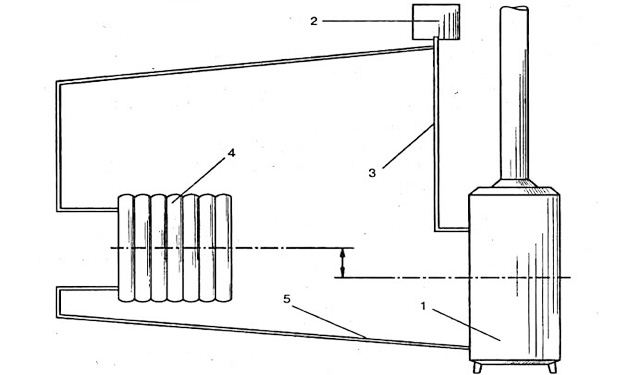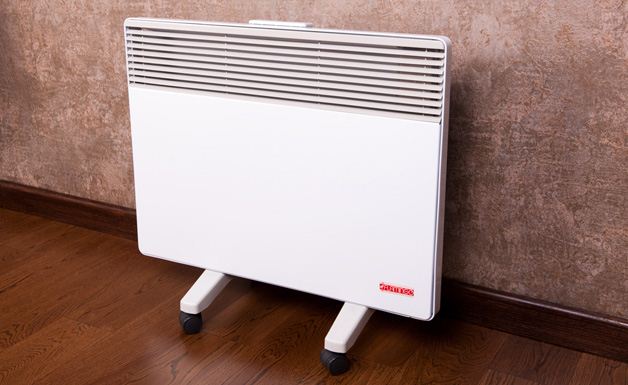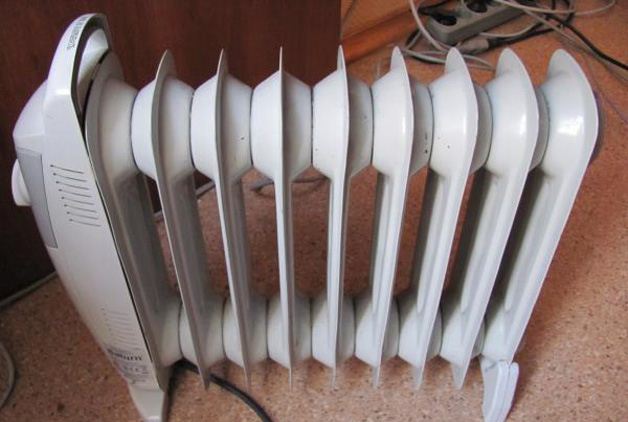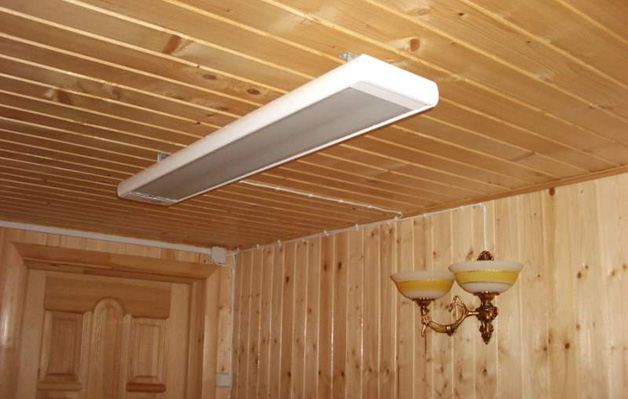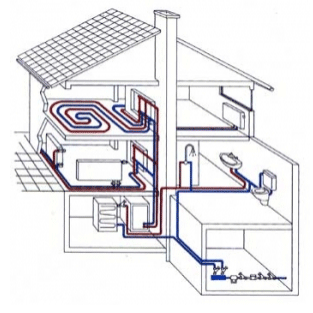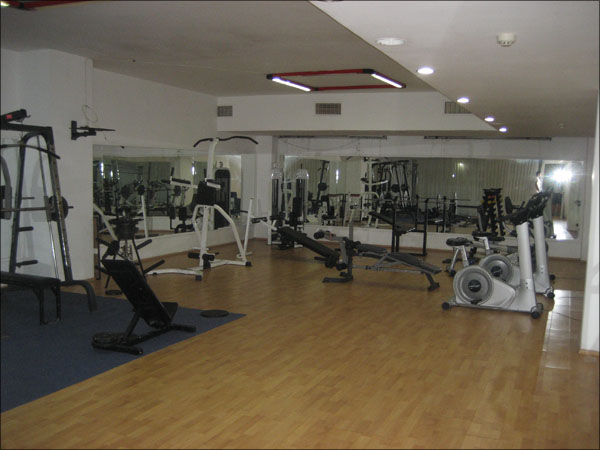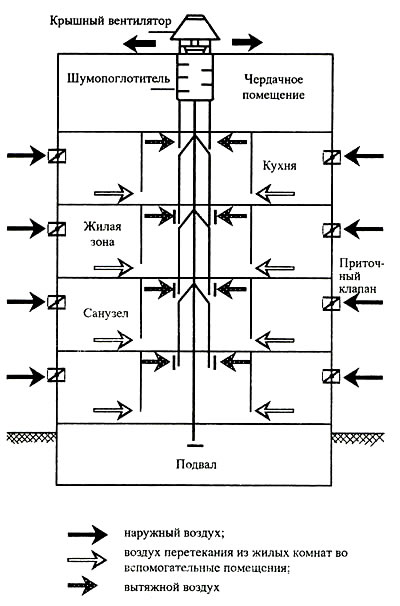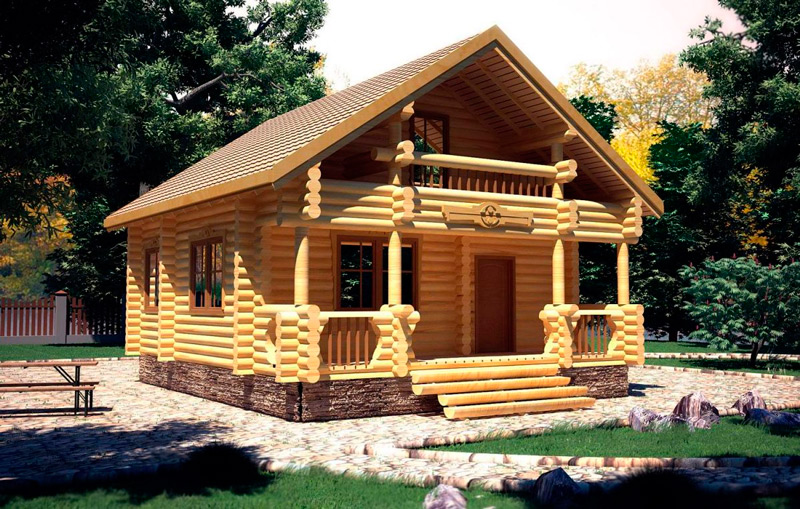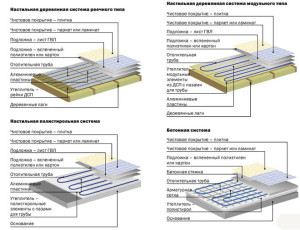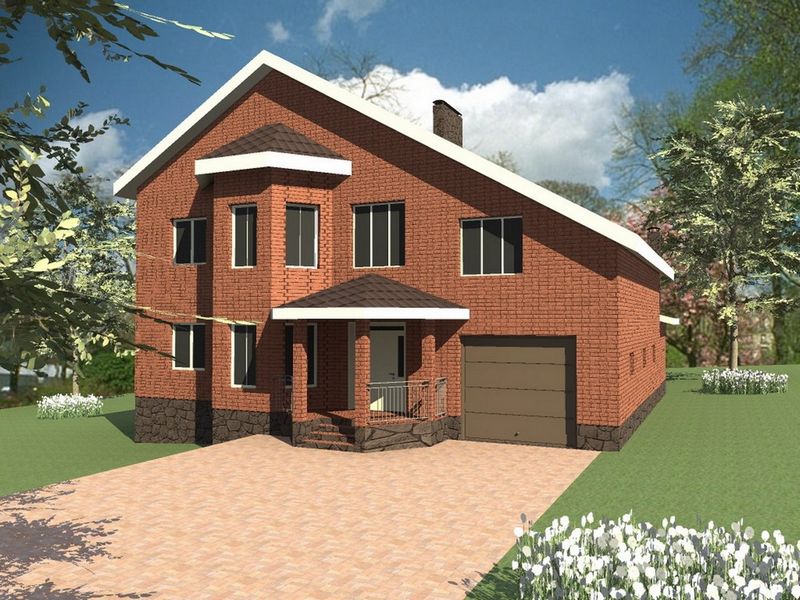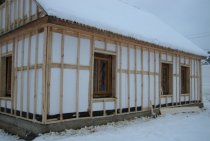Arrangement of heating of underground premises
Heating in the basement is designed to create an optimal temperature regime, which changes during its operation. As a rule, water or air systems are used. The loads of the basement heating system are determined based on the heat balance of the basement.
When the basement is not in use by the owner, the high temperature can be maintained without using a heater - at a depth of more than two meters, the temperature in some regions does not drop below - 0 degrees Celsius.
Competent thermal insulation of the basement walls keeps the temperature at a level of up to degrees of heat without additional heating systems. In addition, communications and equipment also emit heat, which allows you to increase the degree of the room.
Requirements for gas equipment in the basement
When installing gas boilers and other equipment, you must follow the rules for their installation and use. A gas boiler is installed if there is a boiler room in a private house. In the underground of an apartment building, the installation of gas equipment is strictly prohibited.
The requirements for the installation of gas units are as follows:
- Ceilings in the room must be at least 2.5 meters;
- The basement area cannot be less than 4 square meters;
- Natural lighting should be equipped, and for every ten square meters of the room - at least one window opening measuring 0.3 sq.m.;
- Doorways should be at least 80 centimeters wide;
- The basement must be equipped with high-quality ventilation;
- It is necessary to make a gas analyzer that can turn off the gas supply with an electric valve in case of malfunctions.
Operation in the basement of gas equipment should be exclusively in accordance with the rules:
- With open doors to the street
- With an extractor hood, the draft of which is at least three volumes of air per hour;
- The air inflow is calculated by the sum of the exhaust volume with the amount of air required for the operation of the burner;
- A window must be equipped.
Installation of a coaxial chimney for a gas boiler in the basement
As a rule, manufacturers supply this equipment with the boiler. A classic hood for such devices is not required, it will be possible not to remove combustion products from the room.

The device device is characterized by the presence of two tubes, which are located one inside the other without contact. They are taken out into the street. A larger channel is made to remove combustion products, and a small tube drives fresh air.
The advantages of such a device.
The main types of heating systems
Two main types of heating can be immediately distinguished:
- Water heating of a private house, which provides for the installation of radiators and a boiler (gas or electric).
- Stove heating, the organization of which requires the presence of a "potbelly stove" or stove.
Water heating works on the basis of a boiler (it can be electric or gas). Of the main advantages of such a heating system, the constant availability of warm water should be highlighted.
Simple system of water heating: 1-boiler; 2 - expansion tank; 3 - supply pipe; 4 - radiator; 5 - return pipe.
When installing furnace heating, installation of a “potbelly stove” or stove is required. This type of heating is more economical during installation and further use, which is its main advantage. In addition, in this case, you do not need to look for a place to install a bulky boiler. The stove will give off enough heat to heat a small basement of a private house.
But for the effective operation of the system, it is necessary to provide for a chimney device.Here you need to take a responsible approach to the issue and accurately calculate the parameters of the pipes to organize sufficient traction.
Which heating method to choose
Heating a basement or cellar is a rather difficult question. Here it is necessary to take the most responsible approach to the issue of choosing the type of space heating, based on the wishes and requirements of the owner. For example, if it is necessary to heat the basement in a seasonal home (i.e., during the cold spring and autumn months), then installing a simple heater will be enough.
On the other hand, if it is planned to make a full-fledged living space from the basement of a country house, then it is necessary to arrange more efficient heating. The best option in this case is the installation of a furnace or boiler. It should be noted that for the installation of a gas boiler, it is necessary to allocate a separate room, and its work must be coordinated with the relevant services.
http://podvaldoma.ru
As a rule, multi-storey buildings have a basement. Initially, the task of the basement was to create a place where it was possible to place heating equipment and pipelines. Then they began to use it for storing something technical, and then for storing vegetables, fruits, pickles, as in a cellar. Recently, due to the high cost of space and their rent, basements have been used for completely different purposes.
High-quality thermal insulation in the basement will ensure less heat loss.
The basement floor can often be seen converted into a shop, warehouse, office, and even a living space. If the BTI and technical supervision services do not have any questions and claims, then such conversions in the basements are quite acceptable, but they require heating.
Heating with electrical appliances
Electrical appliances for basement heating are the easiest and most budget option. Today, a heater is an indispensable device that is used when it is necessary to comply with a certain temperature regime.
In order for the heaters to work normally, in the basement of a private house, high-quality electrical wiring is required, designed for their total power.
Electrical equipment can be very different. Consider its main types.
Convector heaters
In order to fully heat the large basement of a private house, convectors are best suited. Heaters of this type will help to cope with cold air even in the most severe frosts. Convectors can be made in different types of structures, so you can choose the most convenient type (on the wall or on the floor).
Among the main advantages of such heaters are the following: the room warms up quickly and fully, the device is easy to install, it does not make noise, it can heat the entire building or individual rooms. The main disadvantage is the serious cost of electricity.
Oil heaters
Previously, this type of equipment was used quite widely. For heating, it is necessary to first warm up the oil in the radiator, after which it will begin to give off heat to the room. In this case, the time spent on heating the cellar or basement is much greater than in the case of convectors.
Oil heaters are quite cheap, easy to use, but they are quite heavy and have some installation restrictions. Main advantages: long service life, no noise during operation, affordable price, ease of installation and maintenance, the ability to move.
Infrared heaters
Equipment of this type for heating a basement or cellar is used extremely rarely. The fact is that the devices work in such a way that they heat only those objects and surfaces that are under them or in front of them (in the event that the device is mounted on a wall).Thus, in order to warm the basement completely, it will take considerable time and electricity.
The main advantages of devices of this type are: noiseless operation, high level of reliability and long operation, safety in use, increased efficiency, the ability to heat a certain area. Among the shortcomings, we highlight: stationary installation, high ceilings for installation, with prolonged use there is a possibility of overheating.
Infrared heater mounted on the ceiling.
Selecting a heating option
How to choose the right heating in the basement? A difficult question, the answer to which considers several options. There is no need to rush when choosing heating for the basement, it is important to calculate all the work, in addition, decide in economic terms what will be more profitable and what will be suitable almost ideal for your premises
House heating scheme.
Only after that you have to choose which type of heating is most suitable. To measure the area of the basement, as well as temperature fluctuations, you will need:
- roulette;
- pencil;
- note paper;
- thermometer;
- barometer.
Temperature and humidity readings should be recorded over several days to find out what works for you. After that, analyze the indicators that will show you what kind of humidity is in the basement, how much heat is required for heating. There is equipment that not only heats, but also dries the air, or vice versa, humidifies it. In addition, you will have to take into account the arrangement of the foundation of the room, repairs in the room, the presence of doors and windows.
It is also important how isolated the basement is from common communications. If there is a possibility of tapping into the general heating, remember that there may be problems with payment calculations, since it is not always possible to calculate the correct numbers. However, there are options where individual heating for your particular basement is not suitable.
Chapter 33
How is the amount of payment for heating in non-residential premises of an apartment building determined in the absence of metering devices? for gas and electric energy - by calculation, agreed by the resource supplying organization with the person who has concluded an agreement with it, based on the power and mode of operation of the consuming devices installed in these premises; d) for heating - in accordance with subparagraph 1 of paragraph 1 of Appendix No. 2 to the Rules [note: according to the consumption standard in Gcal / sq.m, i.e. the calculation is the same as for apartments]. Does the rent paid by owners differ from the rent paid by tenants The rent for a dwelling does not depend on the number of registered people.
The Housing Code of the Russian Federation establishes (art.
Who pays for heating in the rented premises
Therefore, in practice, organizations prefer to use the second method. 2. The rent is fixed, "communal" - variable.
With this method, the amount of rent in the contract consists of two parts: - fixed (basic) payment; — variable (additional) payment. A fixed (basic) payment is actually a payment for the area of rented premises (buildings), i.e.
rental fee. The variable (additional) part of the rent is the cost of utilities consumed by the tenant in the billing period. For example, between organizations "Alpha" (landlord) and "Omega" (tenant) concluded a lease agreement for non-residential premises with a total area of 200 sq. m. The terms of the agreement provide that the tenant pays monthly rent in the amount of 33,400 rubles.
The agreement provides that the tenant pays monthly rent in the amount of 167 rubles. for 1 sq. m.In addition, the tenant undertakes to pay monthly the cost of utilities (hot and cold water supply, heating, energy supply, gas supply) in proportion to the area of the leased premises on the basis of invoices issued by the landlord. The landlord is required to confirm the cost of utilities paid by the tenant by providing utility bills. In addition, landlords and tenants may enter into independent agreements on reimbursement of utility costs. For example, an agreement on the reimbursement of expenses for paying utility bills, or an agreement on paying for utilities, or an agreement on participation in the costs of paying utility bills, etc.
Most organizations operate in rented premises. In order to properly operate the premises, tenants use electricity, cold and hot water, heat, gas, i.e.
utilities (clause 4, article 154 of the LC RF). The list of provided utilities is established in each case in the lease agreement. Thus, when receiving property for rent, the tenant has an obligation not only to pay the rent in a timely manner and in full, but also to pay for utilities, unless otherwise provided by law or agreement (clause 2, article 616 of the Civil Code of the Russian Federation). As a rule, tenants pay utilities not to the providers of these services, but to their landlords, thereby compensating their expenses for the "communal".
Basements in an apartment building have a variety of functions. It all depends on the quality of the structure and the location of the central communications, thanks to which water and heat are supplied to the apartments.
Most often, the basement is the property of the residents of this house, and can be equipped to organize shops or cafes. Recently, it has become popular to organize gyms in the basement, but for various kinds of events it is necessary to think carefully and qualitatively, since the air masses naturally do not circulate very well.
It is characterized by high humidity, which can adversely affect human health. For this reason, a variety of fungal colonies and mold will appear on the walls of the room, which are quite difficult to get rid of.
Advantages and disadvantages of the basement
The main advantage of the basement in an apartment building is the concentration of all necessary communications for functional work. From the basement is carried out through ventilation ducts, which are located in each apartment.
There is also a central water supply pipe and heating pipes. As a rule, flow meters are installed on such pipes in order to control the total consumption of the whole house and each tenant individually. In the basement there is also a central sewage system, to which all apartments in the house are connected.
The basement can be used as a storage room, but this is only if a certain space is provided for such purposes. Previously, the basement was used as a bomb shelter. To date, there are still some cellars that have benches or places to rest.
The downside of the basement is the dampness and mustiness of the air due to poor ventilation and lack of natural light.
Advice. To effectively use the basement, it is necessary to provide high-quality ventilation and waterproofing.
gas or electricity

It is recommended to use the mains voltage in the basement not higher than 42 V.
So, an important factor in determining which basement heating you choose will be the purpose of the room. If you plan to equip a living space in the basement, you will need full-fledged heating so that it is warm even in the most terrible frosts.Here, options for steam heating, a gas boiler will be relevant, if the design provides for this. If the ventilation is broken at the basement, then first you need to finish it, plaster all the cracks, from where air can come from outside.
If you are planning an office space or a store, you can opt for a heating system on radiators that operate on the electrical network and are able to heat rooms with a fairly large area. Such heating in the basement will also dry the air, so it is ideal for rooms with high humidity.
But with this choice of heating, you should pay attention to the power of the electrical network where the radiator will be connected. If an office is heated, where there are already so many electrical appliances and electronics, such a voltage will not be able to withstand the network and it will be necessary to install additional equipment, which will incur certain costs in addition to paying for electricity
If the humidity in the basement exceeds the permissible limits, then in addition to heating, you should also worry about drying the air, since moisture destroys the basement as a whole and negatively affects the quality of the air you breathe. So on the basement floor it will turn out to equip comfortable conditions.
If you plan to store something in the basement, use it as a warehouse, and the relatively low temperature will not interfere with storage, you can use an ordinary battery, and installing it will not require any special changes in the design of heating throughout the house.
Infrared heating is an alternative to boilers and batteries. This option has several advantages: short-term installation work, ease of installation of equipment. You can equip it quickly, conveniently, simply and efficiently.
In any case, when installing any kind of heating, consultation with certain responsible services is first necessary. You can only install a heater in the basement on your own, in all other cases you will need the help of specialists, professionals in their field.
It is also better to entrust the calculations that will be associated with the installation of heating in the basement to professionals.
The issue of material for equipment is also important. From what material is it better to choose pipes that will be installed, what batteries are best to choose, or what type of radiator will be of better quality? All these are individual parameters for each particular basement, and only correct calculations and observations of air and humidity can show this.
Petr Kravets
Reading time: 4 minutes
A
A
Basement heating is of interest to both owners of multi-storey buildings and private country cottages. Often they equip bars, billiard rooms, cafes, recreation areas, gyms, saunas or small cinemas.
Organization of thermal protection at home
In places where heating will be done in the basement of a private house, it is necessary to carry out thermal insulation of the outer walls, especially the parts that will be in direct contact with the ground. This will help keep the heat inside and prevent condensation from forming.
In basements without heating, insulation with heat-shielding materials is done, as for a heated one, only additional layers can be added in the ceiling of the room to prevent cold from penetrating into the upper floors.
With external thermal insulation, the basement receives the following advantages:
- There are no cold bridges through which wind and frosty air enter the room;
- When condensation forms, it does not have time to cause a destructive effect on materials and the room;
- Usable space inside the basement does not become smaller;
- It is convenient to inspect the structures, which allows you to notice their damage by fungus or mold in time, as well as defects due to the harm of insects and rodents.

Of the shortcomings, it should be noted:
- It is necessary to protect the layers of thermal insulation from mechanical damage for the period of the entire use of the house, while the cost of protective devices is significantly higher than the layers of thermal insulation material themselves;
- It is difficult to protect against damage from insects, pest control is done with poisons and other toxic substances, which is not always applicable in a residential building;
- When facing with brick, cold can penetrate, which will reduce the degree of heat in the room.
Even when designing a structure, protective work is planned against the following factors:
- The impact of groundwater, which is difficult to dry when it enters the basement, especially in terms of building envelopes;
- Moisture in the concrete mixture during pouring enters the room for a long time, giving dampness and a musty smell;
- Possible capillary rise of water from different sources through the capillaries in the materials from which the basement was built;
- The room air also forms moisture through condensate, the inner layer of thermal insulation is not able to provide absolute tightness, therefore condensate may appear on the walls of the basement. It is also formed from gases from the soil, which can penetrate around the entire perimeter of the basement;
- For internal insulation of a room, materials are often used, the level of water penetration of which is quite high, and when wet, their characteristics are reduced. Then it is necessary to protect them with individual waterproofing works;
- Internal thermal insulation layers make it difficult to drain the basement. Moisture from the soil, concrete and capillary water from the base materials is very difficult to remove and requires long drying. It is required to make high-quality waterproofing;
- Walls that are below ground level are cold, and the warm and humid basement air somehow affects them from the inside, which leads to the formation of moisture with the subsequent destruction of materials.
When equipping a structure that protects against damage, additional layers of thermal protection can be made, both outside and inside. But they have the same disadvantages as the basement, only at the same time they increase the estimate at times.
Heating in the rented premises
The property transferred to the company under the lease agreement must be suitable for use based on its actual purpose. Provided by IP Lukoyanova Yu.V. non-residential premises are provided with a heat supply system, through which the supply of heat necessary for the normal operation of the property is carried out.
Due to the fact that the use of a leased non-residential premises involves the consumption of the supplied energy resources by the tenant, the landlord, as the owner of the premises, is obliged to ensure conditions for the tenant's access to utilities, and, consequently, to pay for them to resource providers. These conclusions of the court of first instance correspond to the legal position set out in the decision of the Presidium of the Supreme Arbitration Court of the Russian Federation dated May 21, 2013 N 13112/12. Under such circumstances, claims to IP Lukoyanova Yu.V.Ulyanovsk, st. Karbysheva, 30, is in municipal ownership. In the period from 07/01/2008 to 03/09/2012, the named premises were leased to the entrepreneur Lukoyanova Yu.V.
in accordance with agreement
N 8883/1415, concluded between her and the Committee for the management of city property of the mayor's office of the city of Ulyanovsk. According to clause 2.2.8 of the agreement, the tenant is obliged, within two weeks from the date of conclusion of this agreement, to conclude agreements with special organizations (either the balance holder or the responsible tenant) for supplying the premises with energy and other resources, maintaining the premises, and also maintaining the building in proportion to occupied area.
However, the heat supply agreement between IP Lukoyanova Yew.The. and resource-supplying organization OAO VTGC was not concluded.
Underfloor heating in the basement
The presence of a warm floor in a living room will be an excellent solution for creating a comfortable environment. Often, warm floors are made even when there is stove heating in the house, since cold air masses that occur during ventilation of the room pass through the floor.
It should be borne in mind that when installing a warm floor in the basement of a private house, special attention must be paid to thermal insulation and waterproofing of the foundation base. As a heater, it is recommended to use a combined solution - mineral wool and expanded polystyrene
Installation of an additional waterproofing layer is necessary if there is a high level of groundwater in the area or there is a possibility of seasonal flooding of the basement.
Underfloor heating options. Click to enlarge.
With a high GWL, a drainage system should be provided at the site
This is very important if an electric underfloor heating is installed in the basement, which should not be exposed to moisture in any case.
Basement types
SNiP 31-02-2001 regulates the types of underground facilities as follows:
Basement
It is a floor with a floor in a room that is half the height of the walls below ground level. This type of room can be forced-heated by additional equipment, or without heating.
Underground
The space under the house between the floor of the first floor and the ground. The bottom of the building, where communication pipelines are laid and equipment is placed, is called the technical underground.
Ground floor
The basement of the house is characterized by a floor mark below the ground, buried at a distance of less than half the height of its walls. In the basement, lighting, heating and other types of work are done, since this room has great functionality and is used as an additional floor of the house.
Cellar
The cellar is buried in the ground, providing food and crop storage throughout the winter. It can be done both under the building and as a separate building, it can be placed under any outbuilding.
